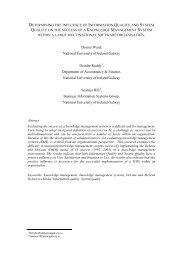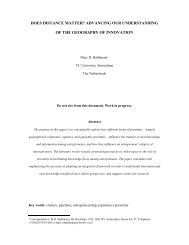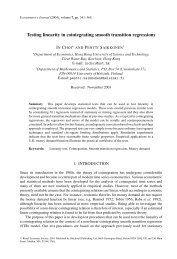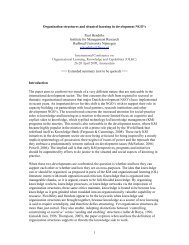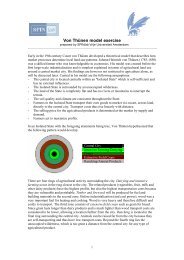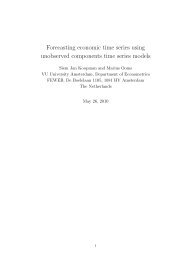The effects of road pricing - Feweb - Vrije Universiteit Amsterdam
The effects of road pricing - Feweb - Vrije Universiteit Amsterdam
The effects of road pricing - Feweb - Vrije Universiteit Amsterdam
Create successful ePaper yourself
Turn your PDF publications into a flip-book with our unique Google optimized e-Paper software.
to maximise social rather than private welfare. This may take the form <strong>of</strong> price<br />
regulation, or taxing firms so that their prices become socially optimal. This will be<br />
explained below.<br />
Deriving optimal prices needs an objective function. <strong>The</strong> most general form <strong>of</strong> this<br />
function is a social welfare function. Formally, a social welfare function<br />
1 n<br />
i<br />
W = W ( V ... V ) has as its arguments the indirect utility functions V <strong>of</strong> individuals<br />
i , i = 1...<br />
N (Varian, 1999). <strong>The</strong>se indirect utility functions indicate the maximum<br />
utility levels <strong>of</strong> the individuals. <strong>The</strong> utility levels depend on prices, income, and the<br />
magnitude <strong>of</strong> externalities such as congestion and pollution. <strong>The</strong> social welfare<br />
function incorporates welfare judgements with respect to the distribution <strong>of</strong> economic<br />
resources. <strong>The</strong>se value judgements are reflected in the policy prescriptions based on<br />
the welfare function.<br />
Several alternatives can be used as a target. <strong>The</strong>se include: the search for local<br />
improvements to welfare (rather than a global optimum); Pareto improvements;<br />
potential Pareto improvements; compensating and equivalent variation; and social<br />
surplus. This last one is the most commonly used for applied welfare analysis. Social<br />
surplus is defined to be the sum <strong>of</strong> producers’ surplus and consumers’ surplus (CS).<br />
Consumers’ surplus represents the benefit to consumers, as expressed by their<br />
willingness to pay, in excess <strong>of</strong> the cost <strong>of</strong> providing a particular quantity or level <strong>of</strong><br />
output. Producers’ surplus represents the revenue in excess <strong>of</strong> the cost <strong>of</strong> providing<br />
that level <strong>of</strong> output, i.e. pr<strong>of</strong>it. <strong>The</strong> principal advantage is that CS can be calculated<br />
using uncompensated aggregate demand curves. On the other hand, CS makes the<br />
implicit welfare judgement that welfare distributional concerns do not matter, by<br />
giving equal weight to the surplus <strong>of</strong> all individuals. Another drawback is that CS is<br />
not an exact measure <strong>of</strong> welfare when the utility function is not quasilinear.<br />
Despite these disadvantages, the considerable practical advantages <strong>of</strong> CS make it<br />
attractive. CS is most commonly used to measure welfare changes associated with the<br />
change in the price <strong>of</strong> a good. Willig (1976) has shown that CS serves as a good<br />
approximation to the compensating and equivalent variation, which are exact<br />
measures <strong>of</strong> changes in welfare, as long as any one <strong>of</strong> three conditions hold:<br />
1. the price change is not large;<br />
2. expenditure on the commodity is not a large fraction <strong>of</strong> income;<br />
3. the income elasticity <strong>of</strong> demand is not large.<br />
12





